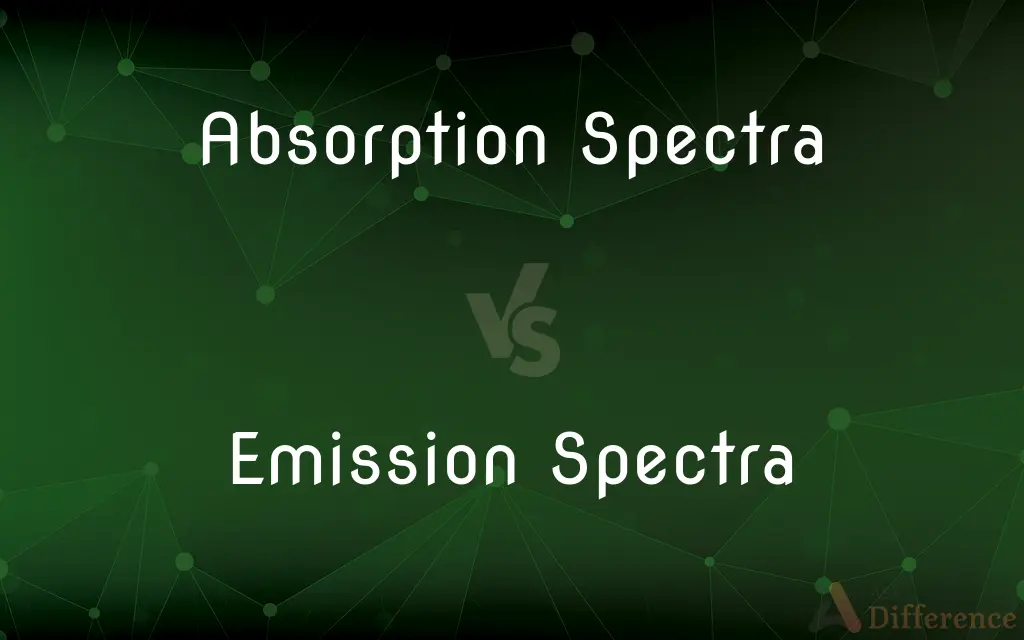Absorption Spectra vs. Emission Spectra — What's the Difference?
By Tayyaba Rehman — Published on December 21, 2023
Absorption Spectra show wavelengths absorbed by a substance, while Emission Spectra display wavelengths emitted.

Difference Between Absorption Spectra and Emission Spectra
Table of Contents
ADVERTISEMENT
Key Differences
Absorption Spectra are graphical representations of the wavelengths of light absorbed by a substance. When light passes through a substance, certain wavelengths are absorbed, resulting in a spectrum with gaps. On the contrary, Emission Spectra represent the wavelengths of light emitted by a substance. When substances are excited (often by heat or electricity), they emit light at specific wavelengths.
At its core, Absorption Spectra tell us what colors or wavelengths are taken in and removed from white light as it passes through a substance. The result is a continuous spectrum with dark lines. Emission Spectra, meanwhile, provide a stark contrast. They display bright lines on a dark background, representing the specific colors or wavelengths a substance releases.
Both Absorption Spectra and Emission Spectra are invaluable in scientific research. Absorption Spectra, for instance, can help determine a substance's composition based on the wavelengths it absorbs. Emission Spectra, on the other hand, are pivotal in fields like astronomy, allowing scientists to determine the composition of distant stars by studying the light they emit.
To create an Absorption Spectra, white light is shone through a sample. The resulting spectrum will have missing wavelengths, shown as dark lines, corresponding to the absorbed light. In contrast, Emission Spectra are generated by exciting a sample and then analyzing the light it emits. The result is a series of bright lines against a dark background, showcasing the emitted wavelengths.
Absorption Spectra play a significant role in areas like spectroscopy and are crucial for tasks such as drug testing and pollution monitoring. Emission Spectra are fundamental in understanding atomic and molecular energy levels and are widely used in astrophysics and quantum mechanics.
ADVERTISEMENT
Comparison Chart
Nature of Spectra
Shows wavelengths absorbed.
Displays wavelengths emitted.
Appearance
Continuous with dark lines.
Dark background with bright lines.
Creation Method
Shining white light through a substance.
Exciting a substance and analyzing emitted light.
Application Fields
Spectroscopy, drug testing, pollution monitoring.
Astrophysics, quantum mechanics, molecular analysis.
Interpretation
Dark lines indicate absorbed wavelengths.
Bright lines showcase emitted wavelengths.
Compare with Definitions
Absorption Spectra
A tool to understand a substance's light absorption properties.
The Absorption Spectra of certain pollutants helps in environmental monitoring.
Emission Spectra
A representation of light emission across various wavelengths.
Neon lights produce colorful Emission Spectra when electrified.
Absorption Spectra
A representation of light absorption across wavelengths.
By analyzing the Absorption Spectra, scientists can determine the composition of substances.
Emission Spectra
Graphical illustration of emitted light frequencies.
The Emission Spectra of hydrogen reveals specific bright lines, indicating its atomic structure.
Absorption Spectra
Graphical depiction of absorbed light frequencies.
The Absorption Spectra of a gas can reveal its identity through unique patterns.
Emission Spectra
A spectrum depicting wavelengths emitted by a substance.
Stars have unique Emission Spectra, letting astronomers study their components.
Absorption Spectra
A spectrum showcasing wavelengths absorbed by a substance.
The Absorption Spectra of chlorophyll has specific dark lines where blue and red light are absorbed.
Emission Spectra
Dark background with distinct bright lines.
The bright lines in the Emission Spectra represent the specific light wavelengths released.
Absorption Spectra
Continuous spectrum interrupted by dark lines.
The dark lines in the Absorption Spectra signify the absence of specific light wavelengths.
Emission Spectra
A tool to fathom a substance's light emission characteristics.
Emission Spectra are essential in quantum mechanics to understand energy transitions.
Common Curiosities
How do we obtain an Absorption Spectra?
By shining white light through a substance and observing the absorbed wavelengths.
What's the Absorption Spectra?
It represents wavelengths of light absorbed by a substance.
Why are Absorption Spectra significant?
They help determine a substance's composition based on absorbed light.
Can Emission Spectra help in understanding atomic structures?
Absolutely, the emitted wavelengths can reveal information about atomic and molecular energy levels.
And what about the appearance of Emission Spectra?
They show bright lines against a predominantly dark background.
How do we generate Emission Spectra?
By exciting a substance and then recording the light it emits.
Can Absorption Spectra and Emission Spectra be related to the same substance?
Yes, the wavelengths absorbed in Absorption Spectra often correlate with those emitted in Emission Spectra.
What's the role of Absorption Spectra in environmental science?
It's crucial for tasks like pollution monitoring.
How does Emission Spectra differ?
Emission Spectra display wavelengths of light a substance emits.
How are Absorption Spectra typically represented?
As a continuous spectrum with distinct dark lines.
Which spectrum would likely be used to study the composition of distant stars?
The Emission Spectra, as stars emit light of specific wavelengths.
Where are Emission Spectra commonly used?
In astrophysics to study stars and in quantum mechanics.
What causes the bright lines in Emission Spectra?
They result from specific wavelengths of light emitted by the excited substance.
Are Absorption Spectra unique to substances?
Yes, different substances absorb specific wavelengths, giving unique patterns.
Do all substances emit light and have an Emission Spectra?
Not all, but many substances emit light when excited, producing their unique Emission Spectra.
Share Your Discovery

Previous Comparison
Fairy Tale vs. Folktale
Next Comparison
Primordial Follicle vs. Primary FollicleAuthor Spotlight
Written by
Tayyaba RehmanTayyaba Rehman is a distinguished writer, currently serving as a primary contributor to askdifference.com. As a researcher in semantics and etymology, Tayyaba's passion for the complexity of languages and their distinctions has found a perfect home on the platform. Tayyaba delves into the intricacies of language, distinguishing between commonly confused words and phrases, thereby providing clarity for readers worldwide.













































